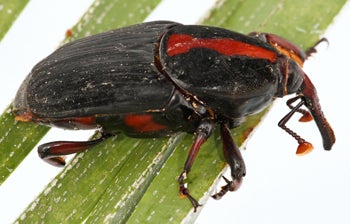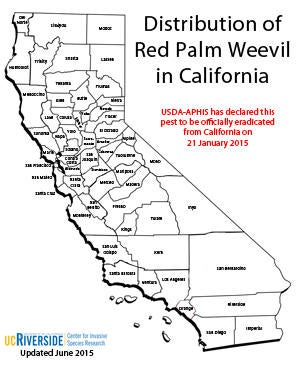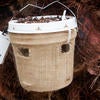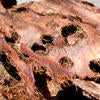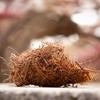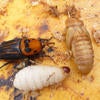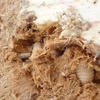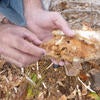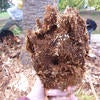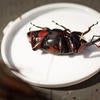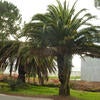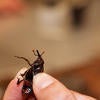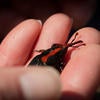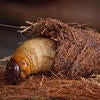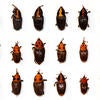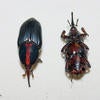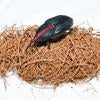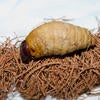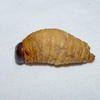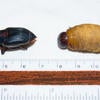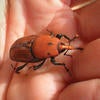Update: Red Palm Weevil Successfully Eradicated from California
Effective January 18, 2015, the Animal and Plant Health Inspection Service (APHIS) has declared eradication of Red Palm Weevil from Laguna Beach California. For more information, please visit the CISR blog post: The Palm Weevil, Rhynchophorus vulneratus, Successfully Eradicated from California
Red Palm Weevil, Rhynchophorus ferrugineus (Olivier) (Coleopetera: Curculionidae)
The Situation: During August 2010, arborists removed a large dying Canary Island date palm (Phoenix canariensis) from a residence in the city of Laguna Beach, Orange County, California and reported finding adult weevils and weevil larvae with associated larval feeding damage in the top portions of the palm trunk. The weevils were subsequently identified as Rhynchophorus ferrugineus, the Red Palm Weevil (RPW), by experts at the USDA-ARS Systematic Entomology Laboratory in Maryland. This was the first record of this pest in the USA.
Monitoring for Red Palm Weevil Populations in California: In response to the RPW collection in Laguna Beach, state and federal survey crews deployed pheromone baited traps. Pheromones are airborne chemicals that elicit behavioral or physiological responses in insects. RPW is highly attracted to two different types of odors: (1) volatiles emanating from unhealthy or damaged palm trees, and (2) aggregation pheromones (commercially available) which male weevils release to attract other male and female weevils to palm trees that are suitable for weevil larvae to use as food. Neither the stressed palm odors or the weevil aggregation pheromone are very effective on their own. However, in combination they can be powerful in attracting weevils to traps. Pheromone traps make it possible to detect very low density pest populations that would otherwise be almost impossible to find.
In addition to pheromone monitoring, visual surveys of other palms in the area surrounding the find site in Laguna Beach were conducted. These visual surveys have confirmed the presence of R. ferrugineus at the original collection site. This collection in Laguna Beach represents the first time R. ferrugineus has been found in the United States. Survey efforts are underway around Laguna Beach to determine if an infestation of Red Palm Weevil exists, how widespread it is, and if it will be possible to contain and perhaps eradicate this highly destructive palm pest.
Dispersal: The international trade in live palms is the most likely conduit that has allowed this pest, probably moved as eggs, larvae, or pupae hidden inside palms, to move vast distances. RPW may establish readily in new areas because it has traveled with its food supply, or there are other ornamental or date palms nearby that it can infest once larvae finish developing and emerge as new adults that abandon their original host plant. Adult weevils are strong fliers and can fly up to 900m (~900 yards) at a time and they can move up to 7 km (~4.3 miles) in 3-5 days.
Distribution: The Red Palm Weevil is native to Southeast Asia and is known from the following regions:
- Asia: Red Palm Weevil has been recorded in Bangladesh, Cambodia, China (Guangdong, Taiwan), Pakistan, India, Indonesia, Japan, Laos, Malaysia (Sabah, Sarawak), Myanmar, Philippines, Singapore, Sri Lanka, Thailand, and Vietnam.
- Africa: Algeria, Egypt, Libya, Madagascar, Malta, Morocco.
- Middle East: Bahrain, Georgia Palestine, Syria, Iran, Iraq, Israel, Jordan, Kuwait, Oman, Qatar, Saudi Arabia, and the United Arab Emirates.
- Europe: Cyprus, France, Greece, Italy, Spain, Portugal, and Turkey.
- Oceania: Papua New Guinea, Samoa, and the Solomon Islands.
- The Caribbean: Aruba.
- The United States: Laguna Beach, Orange County, California
Economic Damage: Red Palm Weevil is widely considered to be the most damaging insect pest of palms in the world. RPW’s are usually attracted to unhealthy palm trees, but they will often attack healthy palms too. Red Palm Weevil larvae feed within the apical growing point of the palms creating extensive damage to palm tissues and weakening the structure of the palm trunk. Palms damaged by RPW may exhibit the following symptoms: (1) presence of tunnels on the trunk or base of fronds. (2) Infested palms may emit "gnawing" sounds caused by larvae feeding inside. (3) Oozing of viscous fluids from tunnels. (4) Appearance of chewed plant material (frass) at the external entrances of feeding tunnels and a highly distinctive "fermented" odor. (5) Empty pupal cases and the bodies of dead adult RPW in and around heavily infested palms, and (6) breaking of the trunk, or toppling of the palm crown. Feeding damage leading to the death of infested palms is widely reported in areas invaded by this pest. The primary hosts of the Red Palm Weevil include 24 species of palms in 14 genera, including most of the common landscape palms found in California. The Canary Island date palm, one of the most conspicuous and prominent palms in California, is especially susceptible to attack. The Red Palm Weevil poses a very serious threat to California’s landscape plantings of ornamental palms if it were to become established here. Commercial date production is impacted in areas where RPW is established, resulting in tree death or reduced vigor in infested date palms. Red Palm Weevil represents a potential threat to California’s $30 million dollar date crop should it become established in date-growing areas of California. Ornamental palm tree sales are estimated at $70 million per year in California, and $127 million in Florida.
Symptoms: Early Red Palm Weevil infestations can be difficult to detect in large palms in the landscape unless access to the actively growing portions can be attained. It is important that arborists and individuals working in palm canopies be vigilant for signs of larval mines and frass (excrement) in leaf bases in the central growing point of the palm in order to detect signs of early infestation. Larval damage to leaf bases anywhere in the canopy revealed by routine trimming may also be a sign of feeding by young Red Palm Weevil larvae. Dieback in the apical (newest, uppermost, or center) leaves in the canopy is a common symptom of larval damage to the meristem tissue and should be investigated for RPW. Frass accumulating at points of injury or at the base of offshoots may also appear in infested trees. Adult weevils are strong fliers and would appear in flight as one of the larger beetles to occur in California urban landscapes.
Identification: Adult Red Palm Weevils are very large beetles, attaining body lengths, including the rostrum of 35 to 40mm (1.4-1.6 inches). The weevils have a long, slender rostrum or “snout” which the female uses to penetrate palm tissue and create access wounds in which eggs are deposited. Coloration in Rhyncophorus ferrugineus is extremely variable and has historically led to the erroneous classification of color-defined polymorphs (variants) as distinct species. Coloration in the adult weevils is predominately reddish-brown in the most typical form. The Red Palm Weevil’s collected in Laguna Beach have displayed a distinct “red striped” coloration which consists of the dorsal surfaces appearing uniformly dark brown to black, with a single, contrasting red stripe running the length of the pronotum. Consequently, there are two different color types or color morphs for RPW, adults that are predominantly reddish in color, and the others that are dark with a red streak, like the Laguna Beach specimens. The Red Palm Weevil, like other beetles, develops through complete metamorphosis, with larvae and pupae developing within the trunk and apical growth tissues of the palm meristem. Larvae are legless grubs with the body color uniformly pale yellow with a brown head. Larvae may attain lengths greater than 50 mm (2 inches). Larvae feed within the soft tissues of the meristem or leaf bases creating frass filled mines, enlarging and penetrating deep within the upper trunk areas as the larvae mature. Mature larvae construct a pupal chamber or cocoon made up of coarse palm fibers in which they pupate and occupy for approximately three to four weeks. The cocoons are located within the damaged tissue of the palm.
Life Cycle: To lay eggs, females use their long beak, or rostrum, to chew a hole into palm tissue. Eggs are then laid into this hole. Eggs may be laid in wounds, cracks, and crevices in the trunk, from the collar region near the roots, up to the base of frond petioles and axils near the crown of the palm. Females can lay 58-531 eggs which hatch in about 1-6 days. Larvae that hatch from eggs, feed on the surrounding palm tissue and bore their way into the center of the palm. The tunnels larvae form as they feed fill with frass (excrement and chewed fibers that have a highly distincitve odor) and plant sap. Larvae may pass through 3-7 instars or stages that may last for about two months before the pupal stage is reached. Larvae pupate inside cocoons in the palm trunk, or in concealed places at the base of palm fronds. The pupal stage may last from 11 to 45 days. The entire life cycle, egg to adult, can take 45 to 139 days. Adult Red Palm Weevil emerge from cocoons, and females can lay eggs for around 8 to 10 weeks. Adult weevils live for about 2 to 3 months feeding on palms, and going through several cycles of mating and egg laying before dying. The sex ratio is slightly biased towards females (1 male to about 1.2 females). In Egypt, it has been estimated that RPW can have up to 21 generations per year. This pest can be reared in the laboratory on sugar cane, and a variety of artificial diets.
Control Options: Suppression of Red Palm Weevil infestations can be attempted in several ways. Insecticides are probably the most common control tool used against Red Palm Weevil, and can applied in a variety of ways for RPW suppression including applications as dusts, liquid sprays. Trunk injections or soil applications of systemic insecticides that move inside the palm poisoning weevil larvae and adults may also be effective. Good sanitation practices are needed to prevent Red Palm Weevil spreading from infested palms. Chipping, burning, and burying infested material deeply can reduce the likelihood that Red Palm Weevil will emerge and escape from infested palms. Mass trapping has been used to reduce Red Palm Weevil densities. In this instance, aggregation pheromones are loaded into bucket traps along with palm material and granular insecticides. RPW adults are attracted by the pheromones and the plant material and fly into buckets. Once inside the bucket trap, the pesticide kills the weevils before they can escape. Biological control is the use of natural enemies, like predators, parasites, and pathogens to kill a pest. Red Palm Weevil is attacked by a variety of different natural enemies including parasites and small predators that attack weevil eggs, while bacteria, fungi, and nematodes can kill weevil larvae. Many of these biological control agents do not provide adequate control of Red Palm Weevil in the field. Host plant resistance can reduce the ability of Red Palm Weevil to damage palms because the weevil is unable to effectively exploit these hosts. The California fan palm, Washingtonia filifera, which is native to southern California and western Arizona, and the European fan palm, Chamaerops humilis, appear to be resistant to Red Palm Weevil infestations.
For latest news on Red Palm Weevil, visit the CISR blog
More Media on the Red Palm Weevil
Visit the CISR blog on the latest RPW News: CISR Blog
CBS Evening News: Red Palm Weevils make California gardeners See red
LA Times: Red Palm Weevil spotted in Southern California, alarming palm tree growers and scientist
New York Times: "Waiter, there's soup in my bug"
CISR: Red Palm Weevils - Food or Foe?
Biology and Management of Palm Weevils Robin M. Giblin-Davis
Red Palm Weevil Notes Dan Gerling
Surveillance and Early Detection of Red Palm Weevil Dr. a.m. Oehlschlager
Red Palm Weevil, Trap and Lure Technical Information AgBio Inc
Biology and Management of Red Palm Weevil in Saudi Arabia Polana SPV Vidyasagar
Advances in the Management of the Red Palm Weevil in Spain Josep A. Jacas
Occurrence and Damage of Red Palm Weevil in China Ren Li
Biology and Management of the Red Palm Weevil: India J.R. Faleiro
Establishment of National Date Palm Research Center Al-Hassa, Kingom of Saudi Arabia
Pheromone Traps for the Management of Red Palm Weevil ICAR Research Complex
How to Control Red Palm Weevil Research Center Al-Hassa, Kingdom of Saudi Arabia
Coconut Pest Alert! Infokus
Gobierno de Canarias: El Picudo Rojo en Canarias
UCANR: El Picudo Rojo de las Palmeras
DOC5: Red Pam Weevil Plague Documentary
CBS Evening News: Red Palm Weevils make California Gardeners see Red
CISR/Dr. Sahin Ince: Red Palm Weevil Egg Laying Behavior
CISR/Mark Hoddle: Overview of the Red Palm Weevil
UCR Blog: Laguna Beach Palm Removal
Center for Invasive Species Research, University of California Riverside
Article provided by: Nick Nisson, Donald Hodel, and Mark S. Hoddle.
Photos by Donald Hodel, John Kabashima, Christina Hoddle and Mike Lewis
Nick Nisson, County Entomologist, Agricultural Commissioner's Office, Orange County
Retired
Donald Hodel, Environmental Horticulturist
drhodel@ucdavis.edu
Mark Hoddle, Extension Specialist and Director of Center for Invasive Species Research
mark.hoddle@ucr.edu
Personal Website
Media within CISR is licensed under a Creative Commons Attribution-NonCommercial-NoDerivs 3.0 Unported License. Permissions beyond this scope may be available at www.cisr.ucr.edu/media-usage.


